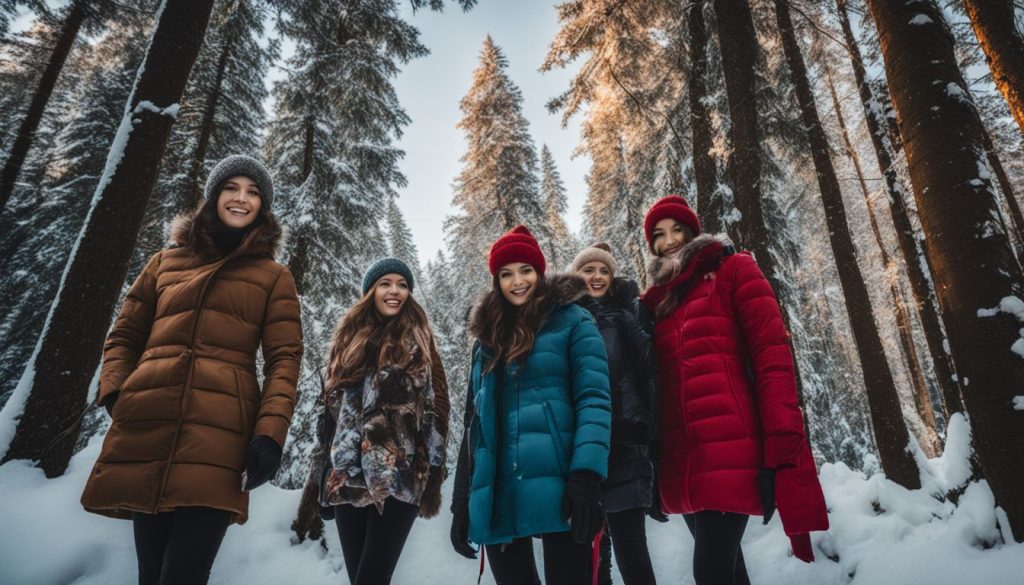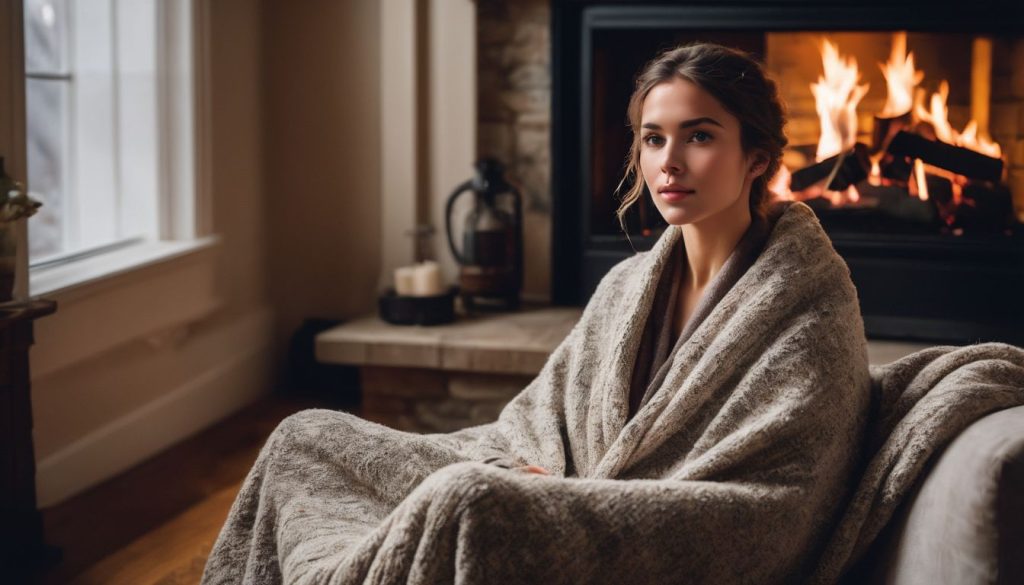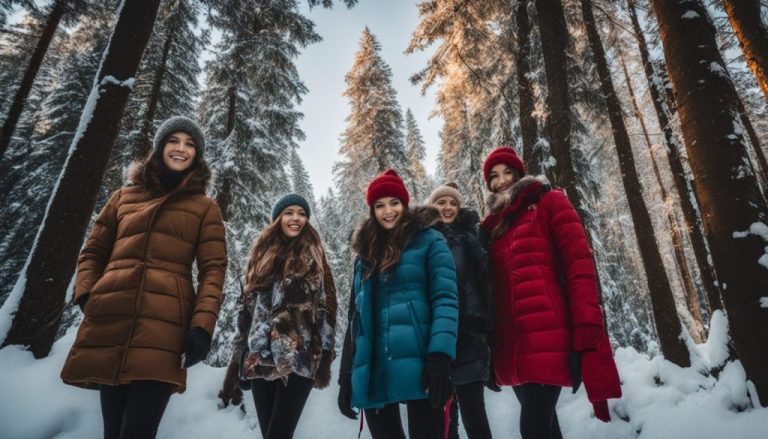Dive into the ultimate winter comfort with fabrics that blend tradition and innovation, ensuring you never compromise on warmth or style. From the plush embrace of cashmere to the resilience of polyester blends, explore an array of textiles perfect for crafting your winter wardrobe. Discover more about these cozy fabric choices and find exclusive winter apparel at InktasticMerch.
As the icy grip of winter takes hold, selecting the right fabric to keep you snug becomes essential. Did you know that cotton can be manufactured to suit both cool winter days and warm summer afternoons? Our guide explores the ten finest fabrics for cold weather, ensuring you stay comfortable and warm.
Welcome your warmest winter yet.
Key Takeaways
- Merino and Icelandic wool stand out for their superior insulation, thanks to natural fibers that trap heat with air pockets.
- Cashmere presents a luxurious and ultra-warm option, outshining other wools in softness and warmth.
- Fleece is perfect for active outdoor use, offering warmth, softness, moisture resistance, and durability.
- Silk serves as an excellent thermal base layer with its lightweight insulation, breathability, and hypoallergenic qualities.
- Polyester is noted for its resilience, quick-drying nature, and style versatility, particularly in synthetic blends such as Sherpa polyester.
Top 10 Best Fabrics for Cold Weather

With temperatures falling, the quest for warmth and comfort becomes paramount. Choosing the right fabrics for your winter attire can truly enhance your cold-weather experience. Let’s delve into the top choices in textiles known for their insulation and comfort during the chilly season.
Wool
Wool is a standout when it comes to fabrics that offer warmth in cold temperatures. Its natural fibers fashion tiny air pockets, making it a robust shield against the chill.
Resilient and lightweight, wool is a long-lasting addition to any winter closet, ensuring you stay cozy year after year. Choosing Merino wool adds an extra layer of comfort with its unmatched softness, keeping you warm without irritation.
Icelandic wool takes it a step further with its outstanding insulation, proven to be warmer than both cotton and polyester. Tweed and flannel are also noteworthy, with tightly woven textures that effectively trap body heat and block out cold air.
As we move beyond conventional materials, discover why cashmere garners its reputation as the luxury fabric of choice.
Cashmere
Extending beyond wool’s classic warmth, cashmere emerges as a sophisticated option for winter. Known for its ultra-soft feel and exceptional heat retention, cashmere brings both style and comfort.
It distinguishes itself by being considerably warmer than the finest merino wools, making it perfect for those seeking extra warmth.
Although associated with luxury and style, high-quality cashmere is remarkably sturdy when maintained properly, retaining its form and softness winter after winter.
Despite sustainability concerns in production, cashmere’s longevity means less frequent replacements, enhancing its value with every fiber.
Silk
Transitioning from the cozy warmth of fleece, we focus on silk—a fabric that excels as a thermal base layer for brisk winter days.
Light as it is, silk excels at insulating, holding warmth close to your body like an unseen shield, ensuring you stay cozy without adding extra layers. This quality makes silk a smart and stylish choice for anyone wanting warmth over weight.
Beyond its thermal attributes, silk is hypoallergenic and gentle on the skin, providing irritation-free comfort. Its breathability is perfect for sensitive skin, quickly wicking away moisture to keep you dry and comfortable.
Incorporating silk into your winter wardrobe as a base layer means embracing both sophistication and practicality, supporting your cold-weather activities with unmatched ease and charm.
Polyester
Polyester emerges as an essential winter fabric, combining warmth and resilience without burdening your ensemble. This synthetic fiber traps heat effectively and dries quickly post-snow or rain, ideal for the winter enthusiast.
Its easy care frees your time for adventure rather than laundry concerns.
Polyester doesn’t compromise on style, with Sherpa polyester mimicking the rich texture of wool, adding both warmth and aesthetic appeal to any garment it graces, from jackets to blankets.
This fabric boosts insulation and introduces a cozy charm to your winter layers. By choosing polyester, you ensure your winter wardrobe is both comfortable and fashionable.
Fleece

Fleece is a winter wardrobe staple due to its exceptional warmth. With its soft, napped surface, fleece is designed to trap heat, ensuring you remain snug even in the most frigid conditions.
Adding fleece to your collection embraces a fabric known for its superior heat retention, whether you’re on the slopes or facing winter winds.
Not only is it cozy, but fleece is also durable, standing up to numerous washes and adverse weather, making it an excellent choice for lasting winter wear.
If caught in a sudden shower or snow, fleece repels moisture and dries swiftly, maintaining comfort. Opting for fleece gear is your best bet for battling harsh weather without forgoing comfort or practicality.
Cotton
Cotton remains a trusted choice for those seeking comfort and longevity in their winter apparel. Its natural fibers offer reliable warmth when the temperature plummets.
However, what sets cotton apart is its adaptability, serving as a go-to fabric for both summer and winter, underscoring its importance in any wardrobe.
Nonetheless, cotton’s moisture absorption can be problematic in colder climates; snow or perspiration can leave you feeling chilly because damp cotton is less effective at retaining warmth.
Much of its insulating properties.
For optimal warmth and dryness, try pairing cotton with thermal fabrics that wick away moisture, or reserve it for days when its breathability can shine without the threat of dampness cooling you down.
Leather
Leather emerges as an exemplary choice for chilly climes, renowned for its remarkable ability to retain heat. This robust material has protected against harsh winds through time, ensuring warmth and comfort.
Whether you don a leather jacket, shoes, or pants, these aren’t merely style choices but are functional winter garments engineered to endure frigid settings.
Faux leather options also offer similar thermal advantages, proving leather’s flexibility in catering to style preferences while focusing on insulation. Discovering the city’s icy streets or going on a frosty escapade, leather in your winter gear guarantees formidable defense against the elements.
Fur
Fur introduces unparalleled warmth and natural insulation to your winter gear. Its dense, soft hairs secure warmth nearby, making it a highly favored material for tackling the cold.
With both authentic fur and superior faux alternatives, you receive a cozy barrier against the cold; being a stylish yet purposeful pick for winter clothing and accessories.
Opting for fur is choosing lasting warmth during severe cold spells. Its exceptional thermal attributes keep you warm, whether facing a bitter storm or enjoying a chilly walk. Fur doesn’t just keep you warm; it also lends a luxurious touch to winter outfits, merging timeless grace with effective heat retention in the cold.
Velvet
Velvet is a lavish choice for those desiring a blend of elegance and warmth in winter wear. Its thick, plush feel insulates against the chill, making it a top cold-weather essential.
With its lush sheen and rich texture, velvet infuses a stylish flair into any winter collection.
Through the art of cut pile weaving, velvet offers unrivaled comfort pleasing both to the hand and eye. Whether you select classic velvet, the shorter pile velveteen, or stretchable velour, each ensures style pairs with warmth.
Leaving behind this royal fabric, let’s venture into Mashru Gaji next—a mix recognized for merging silk-like luxury with practical heat retention.
Mashru Gaji
While velvet provides a lavish experience, Mashru Gaji is essential for superior warmth and comfort in frostbite-inducing conditions. This distinctive wool material, a standout for insulation among winter fabrics, stands as an excellent pick for those seeking warmth in plummeting temperatures.
With fibers woven tightly, heat is retained near your body, working as a thermal shield against cold weather.
Earning its spot alongside wool and cashmere, Mashru Gaji ranks highly for winter attire. Be it layering for outdoor thrills or choosing to remain cozy indoors, clothing from this textile is a must-have in every winter wardrobe.
Offering not just warmth but also breathability, Mashru Gaji ensures you stay comfortably warm without overheating through the colder days.
How to Choose the Best Fabric for Your Winter Clothing

Choosing the perfect fabric for winter clothing is not just about aesthetics; it’s about selecting materials that offer protection against the cold while ensuring comfort.
Discover the secrets to fabric choices that blend warmth with practicality, making sure your winter fashion can handle whatever the season throws at it.
Prioritize Warmth, Breathability, and Moisture Management
When selecting winter fabrics, focus on retaining heat without compromising comfort. Insulating materials capture warmth by creating a barrier against the cold. Wool stands out for its ability to keep you warm while allowing breathability, minimizing the risk of overheating.
Fabrics that manage moisture are vital for staying dry during winter activities. A merino wool-polyester mix excels at wicking away moisture and combating odors, making it perfect for active wear where thermal regulation is crucial.
Seek these qualities to ensure your winter wardrobe delivers optimal performance and comfort.
Embrace Natural Fabrics or Blends
Natural materials like wool and cotton bring exceptional warmth and breathability to winter apparel. Wool, with its outstanding insulating ability, is unmatched for cold days.
It keeps you snug by holding in body heat while wicking moisture away to avoid feeling damp. Cotton offers softness and comfort, especially in forms like flannel or denim—ideal for casual outings or an office day.
Blended fabrics combine the comfort of natural fibers with the durability of manmade materials, often improving a garment’s shape retention alongside its warmth.
These blends can offer additional benefits like easy maintenance or stretchability, which pure natural fibers might lack. When choosing winter essentials, consider how these blends enhance both function and style.
Evaluate the Fabric Weight
The weight of the fabric significantly impacts how effectively your clothing shields you from the cold. Heavier materials usually provide better insulation, conserving warmth and thwarting the chill.
Think of a thick wool coat; its dense fibers are superb at retaining heat. Conversely, lighter fabrics might not suffice alone but are ideal for layering.
Choosing a wool-acrylic blend can give you warmth without excessive bulk, benefiting from wool’s insulation and acrylic’s durability and affordability.
Always consider the heft of fabrics, along with other features, to ensure they suit outdoor activities or cozy gatherings. Smart choices based on weight ensure warmth, comfort, and style without restricting movement.
Match Clothing Type to Activity Level
Once you’ve evaluated fabric weight, think about the garments’ purpose. Various activities require different clothing types, so understanding this can help you select materials that boost both performance and comfort.
For those who are constantly active, the unparalleled flexibility of athletic wear like spandex is essential for staying warm without hindering movement—especially crucial when the outside chills intensify but your energy doesn’t falter.
Opting for weather-resistant fabrics such as Gore-Tex is crucial for winter sports enthusiasts facing high exposure to the elements. This material not only stands firm against severe conditions but also allows perspiration to evaporate, preventing damp clothing from becoming a bothersome issue.
Adventure seekers can benefit from the combination of synthetic blends with insulating fabrics, which provides optimal thermal protection while remaining sufficiently lightweight to support agility and endurance during energetic activities.
Conclusion – The Best Fabrics for Cold Weather
Face the winter chill with assurance by choosing fabrics that are both stylish and functional. Envelop yourself in warmth like a snug embrace with materials specifically designed for colder climates. Your textile choices can be as fashionable as they are practical.
Wise decisions enable comfort, no matter how low the temperatures get. Let these suggestions help you balance fashion and practicality throughout winter.
FAQs
1. What fabrics are best for keeping warm in the cold weather?
Wool, fleece, and thermal cotton are among the most effective materials for staying warm during winter.
2. Can I wear silk in cold weather?
Yes, silk is an excellent choice, offering insulation while remaining lightweight.
3. Are synthetic fabrics good for winter?
Synthetic fabrics like polyester and nylon are superb at retaining heat and repelling moisture in winter weather.
4. Is denim a suitable fabric for cold climates?
Denim is suitable for mild cold conditions but may not offer adequate insulation in extreme cold without additional layering.
5. Do I need to layer different fabrics to stay warm outdoors?
Layering various fabrics, such as wool beneath jackets or coats, adds essential protection against severe cold.
Explore our Blog for more insights on staying stylish and comfortable in every season, with tips and guides to help you make the best fabric choices year-round.




